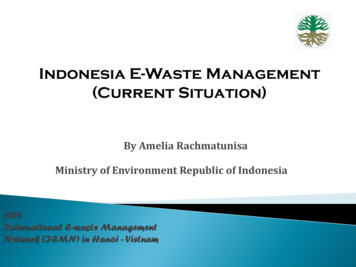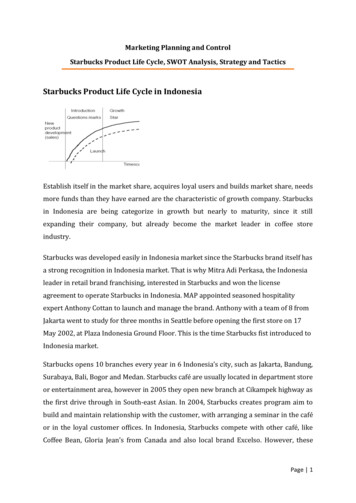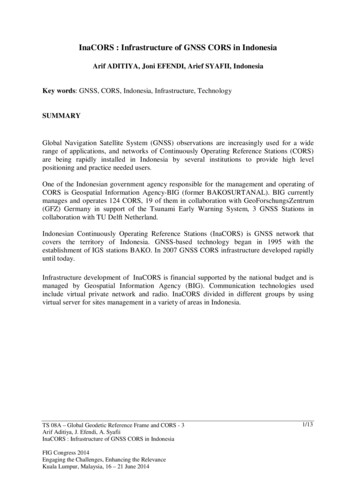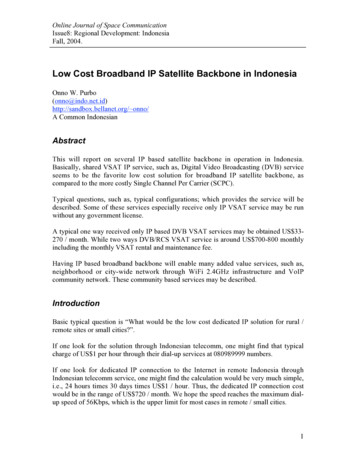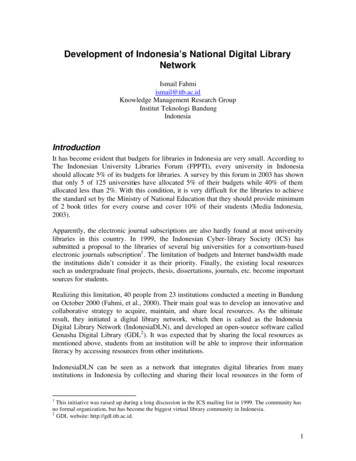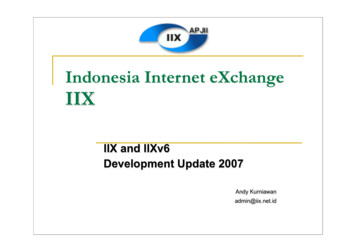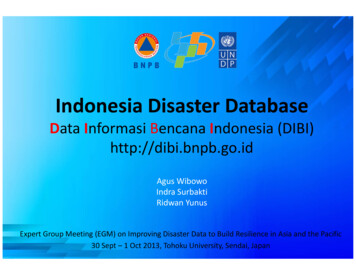
Transcription
Indonesia Disaster DatabaseData Informasi Bencana Indonesia (DIBI)http://dibi.bnpb.go.idAgus WibowoIndra SurbaktiRidwan YunusExpert Group Meeting (EGM) on Improving Disaster Data to Build Resilience in Asia and the Pacific30 Sept – 1 Oct 2013, Tohoku University, Sendai, Japan
Presentation Outlines Disaster Profile in Indonesia Introduction to Indonesia National Agency forDisaster Management (BNPB) Development of Indonesia National DisasterDatabase (DIBI) DIBI application Future development of DIBI
DISASTER PROFILE in INDONESIA Indonesia is located in disaster prone area, can be considered asLaboratory of Disasters, due to its geographical, geological anddemographic condition. Intensity of disasters is increasing and becoming more complex,must use multi-sectoral and multi-disciplinary approach, in integratedand coordinated manner Emphasize the need for disaster management system. Law No. 24/2007 on Disaster Management as the basis to developNational System for Disaster Management in Indonesia3
Disasters in Indonesia (The Law24/2007 about the DisasterManagement, Chapter I: General Requirements, section 1 ) Natural Disasters– (1) earthquake, (2) tsunami, (3) volcano eruption,(4) flood, (5) drought, (6) typhoon, (7) landslide Un-Natural Disasters– (8) technology failure, (9) Land and forest fire,(10) epidemic, (11) disease Social Disasters– (12) social conflict among groups or community(13) terror
Disasters Event in IndonesiaYear 2000-2010 Disaster events increased significantly. 70% hydro-meteorological disasters Trend disasters will increase in future with increasing global climate change andenvironmental degradation.1835130288881489669253319012282744
Indonesian National DM SystemLEGISLATIONPLANNINGINSTITUTIONBUDGETCAPACITY DEVELOPMENTIMPLEMENTATION OF DISASTER MANAGEMENT
Legislation National: Disaster Management Law No. 24/2007 Government Regulations Disaster Management Implementation (Govt. Reg No. 21/2007) Funding and Management of Disaster Assistance (Govt. Reg No. 22/2007) Participation of International Institutions and Foreign Non Government Institutions inDisaster Management (Govt. Reg. No. 23/2007) Presidential Regulation Presidential Regulation No. 8 Year 2008: Establishment of BNPB Decision on status and level of disaster (in the process) Ministerial/BNPB Regulation MoHA Reg Nr. 131 / 2004: Disaster Management in the Local Level MoHA Reg Nr. 46/2008: Guidelines for Organization Structure of BPBD Head of BNPB Reg Nr. 3/2008: Guidelines for the Establishment of BPBD Provincial / District / Municipality Local Regulations (PerDa) Establishment of BPBD
Institutional- National level : B N P BEstablished by PresidentialRegulation No. 8 of 2008.- Provincial/District level:BPBD established by RegionalRegulation.BNPB & BPBD have 3 functions:CoordinationCommandImplementation- National and Local PlatformsBNPBSteering CommitteeExecutive BodyBPBD(Provincial Level)Steering Committee33 BPBDExecutive BodyBPBD(District Level)379 BPBD- Thematic & hazard-based PlatformsSteering CommitteeExecutive Body
PLANNING Integration of DM into DevelopmentPlanning (National/Provincial/District) DM in Long-term/Mediumterm/Annual Development Plan Development of National ActionPlan for DRR Development of National Plan onDisaster Management 2010 2014 DM Planning and the Guidelines DM Plan (in progress) Contingency Plan (in 6provinces/24 districts) Emergency Plan (in progress) Recovery Plan (DLA/PDNAmethodology)FUNDINGRoutine FundingTo supportministries/departments’ routineand operational activitiesespecially for DRR.Contingency FundingBudget allocated for emergencypreparednessOn call FundingBudget for emergency responseSocial Assistance Funding as grantBudget allocated for post-disasterassistanceFunding originated from community
Organization Structure of BNPBIt was established in 2008 to replace the National Disaster ManagementCoordinating Board (SATKORLAK PB) that was established in 1979.PRESIDENT OF THEREPUBLIC OF INDONESIAHead of BNPBDr. Syamsul Maarif, MSi.Head of BNPBPermanentAuditorPermanentSecretaryCentre of Data Information & PRDeputy forPrevention &PreparednessDeputy forEmergencyRespondEOCCentre of Education & TrainingDeputy forRehabilitation &ReconstructionDeputy forLogistic &Equipment
Development of Indonesia Disaster Database (DIBI)20062007UNDP introducedthe technology“DesInventar"20082009DIBI Launching- HandoverDesInventar toBNPB- Establishment ofcommunicationforum Data &InformationManagementDisaster.- Training- Socialization in someprovinces- Mainstreaming genderinto DIBI- Disaster Prone AreaIndex 2009- PNPM MIS,DesInventar and DIBIInterface2010- Training- Socialization insome provinces- Launching DIBIProvinces- Provincial HDRI2011- Training- Socialization in someprovinces- Launching DIBIProvinces- Provincial HDRI- Disaster Prone AreaIndex 20102012- Training- Socialization insome provinces- Launching DIBIProvinces- Provincial HDRI- Develop DIBIGuideline- National andProvincial RiskAssessment- UNFPA facilitatedBNPB-BPScooperation: dataassessment- Draft BNPB-BPSMoU2013- Training- Socialization in someprovinces- Disaster Prone AreaIndex 2012- BNPB-BPS MoU issigned- Server-Server databaseconnection- adding populationbaseline module to DIBI- Develop guide linebook of population datafor DM- National AssessmentReport (NAR)
Name of Database : Indonesian Disaster Data and Information (DIBI) URL of Database: http://dibi.bnpb.go.id Sources of Data : Government of Indonesia Period of Data : 1815 – 2013 Host agency: National Agency for Disaster Management (BNPB) Data collection: Using paper-based data collection format from governmentvalidated data12
The Mechanism of Managing Disaster DataRapidResponseTeamBPBDMediaOperation and ControlCentreVerification &validation forregionData, Informationand PublicRelations CenterVerification &validation with therelated institutionPresident ReportSpecial ReportDisaster data bookDaily Report of EOCDIBI Application
The Characteristic of Disaster Data and InformationBNPBDataDetailNationalProvincial BPBDDistrict/City BPBDThe smallest data unit : district/cityThe function of data : for national coordination,general policy, guidelines, and foreign cooperationDominant data type : secondary dataThe smallest data unit : sub districtThe function of data : to coordinate with theprovince, making guidelines, specific policy andcooperation in province levelDominant data type: secondary dataThe smallest data unit : villageThe function of data : controlling and managingdisaster management operationDominant data type: primer data
Preliminary AnalysisSome Preliminary analysis has been done in Indonesia, such as:National Level:Support of national risk maps, disaster prone area index and the history disasterrisk index (HDRI).As input on National Disaster Management Plan and National Action Plan forDisaster Risk Reduction.National Assessment Report (NAR)Disaster Deficit Index (DDI)Provincial Level:Provincial disasters profileAs input in the preparation of the Provincial Disaster Management Plan andAction Plan for Disaster Risk Reduction.15
Improve of Disaster Prone Area Index in IndonesiaData 1997-2007Data 1815-2010 The development of risk maps hasbeen conducted following theestablishment of local DIBI. DIBI is an example of suchtechnology, which has beenadapted for local data andindicators, and has been used in riskmapping and risk indexing. Inaddition to the above, the projecthas also supported NDPA to link theManagement Information Systemfor PNPM Mandiri to DIBI, henceenabling cross-referencing betweenDRR and poverty.
Application and Use of the Database DIBI Some DIBI data usage, such as:1.Indonesia historical database was officially used to create disaster-prone area index (IRBI) for thedetermination of district who should be have BPBD.2.Used as a proxy indicator of risk map.3.Disaster prone area index used by the Ministry of Finance to allocated Special Allocation Fund forDisaster Management in District/City level.4.Support the National Disaster Management Plan.5.Support the National Action Plan for Disaster Risk Reduction.6.Support for national programme policies and development plans to reduce the vulnerability ofpeople living in highly-disaster prone areas in many ministry/agency : the National RuralCommunity Empowerment Programme (PNPM Mandiri); School and Hospital Safer Programme;the Rice for the Poor Programme; and Social Security for Vulnerable Senior Citizens Programme7.Disaster Information Bulletin (monthly)8.Indonesia Disaster Data Book (annually)9.Indonesia Disaster Atlas (annually)10. Disaster Master plan11. National Assessment Report (NAR)12. Disaster Deficit Index (DDI)13. Used by University as research etc.17
SOURCE AND USE OF DATAData SourcesIRBIHDRIRisk AssessmentDDINARDaLaPDNABaseline DataXXXXXXXBasemapXXXXXXXXXXXXHazards MapDisaster EventXXXXXXXDisaster ImpactXXXXXXXPopulationXXXXXXVulnerable GroupsXHousingXXXXXXXInfrastructure (Public)XXXXXXXXXInfrastructure (Vital)XLocal GovernmentBudgetXXXX
Sustainability1. Regulation from chief of BNPB for guidelineimplementing historical disaster database.2. Establishment of DIBI Forum of National and SubNational.3. Historical disaster data used for re new disasterprone area index.4. DIBI cloudDevelopment DIBI provincial level:1.2.3.4.5.6.7.8.9.10.BaliYogyakartaCentral JavaEast JavaAcehWest SumatraBengkuluEast Nusa TenggaraNorth SulawesiMaluku11. South Sumatera19
Progress of establishment DIBI at Province Level: Established: Next development
UNFPA InitiativesNational Seminar on optimizing population and secondary datafor disaster management conducted by BNPB-BPS-UNFPA in2012 presentation on BNPB disaster analysis and the impactto the populationIntegration of population component into the tsunami master planDevelopment of population data sets for any disasterpreparedness activitiesDevelopment of baseline data and information through mergingthe data from 2010 population census and 2011 Village potentialsurvey21
MoU signing between BNPB and BPSNational Seminar Optimizing Populationand Secondary Data for DM, 5-6 June 2012BNPB – BPS MoU signing 6 February 2013at the 5 years anniversary of BNPB22
New Population Data Menu on DIBI
Problems and Challenges Difficult to collect disaster impact and lostLimited / un available IT expert to manage HW/SWInsufficient of electricity supplyInternet connection problemsLimited budgetOrganizational changesHigh personnel turn over especially in local officesServer need to be upgraded for supporting more usersSoftware need to be upgraded to new application i.e. PHP,Python
Future DIBI DIBI cloud Connect to other line ministries database i.e.BIG/Bakosurtanal, Ministry of Finance, etc. Support temporal GIS Mobile access – data can be accessed from mobiledevices (Apple, Android, Windows) Adopt GLIDE numbering system for unique disasterevent
Thank YouTerima KasihNational Agency for Disaster ManagementJl. Ir. H. Juanda No. 36 Jakarta Pusat, Indonesia 10120Telp.: 62-21-3458400Fax.: 62-21-3458500Email: contact@bnpb.go.idWebsite: www.bnpb.go.idFacebook: www.facebook.com/infoBNPBTwitter: @BNPB IndonesiaYouTube: BNPBIndonesia
2. Used as a proxy indicator of risk map. 3. Disaster prone area index used by the Ministry of Finance to allocated Special Allocation Fund for Disaster Management in District/City level. 4. Support the National Disaster Management Plan. 5. Support the National Action Plan for Disaster Risk Reduction. 6. Support for national programmepolicies and development plans to reduce the vulnerability of


